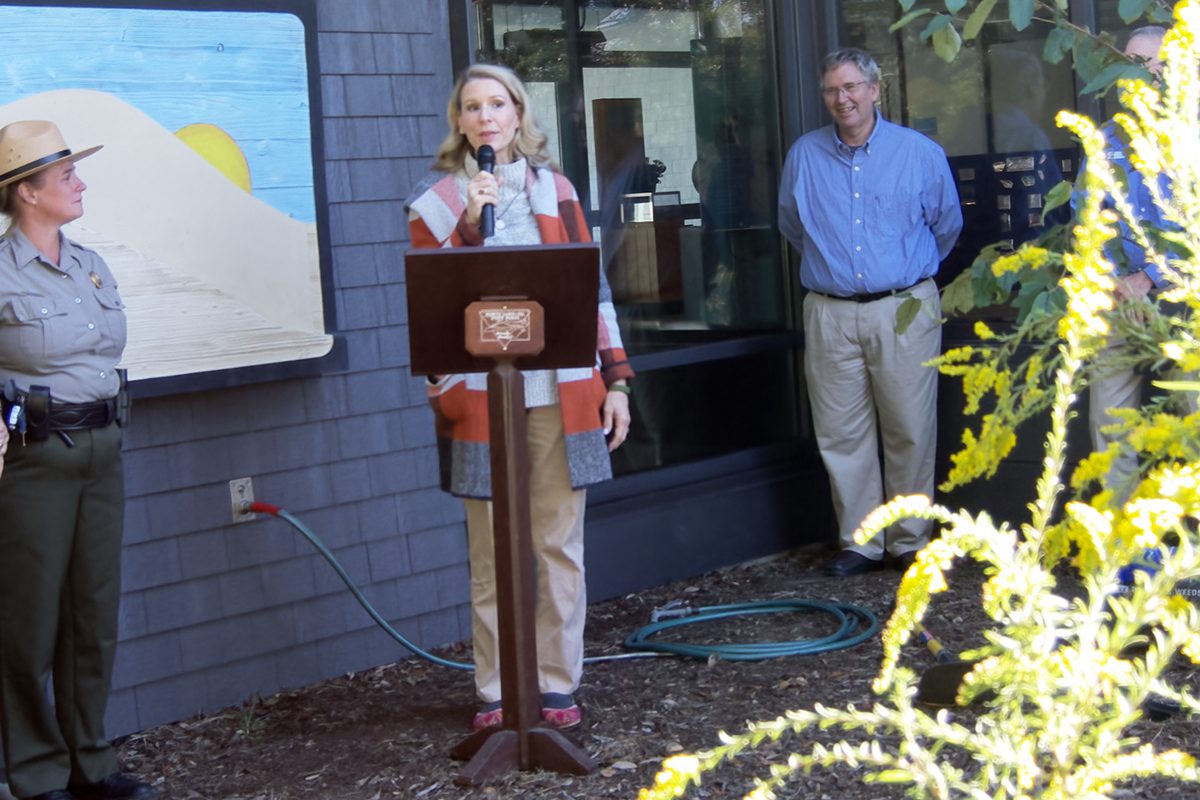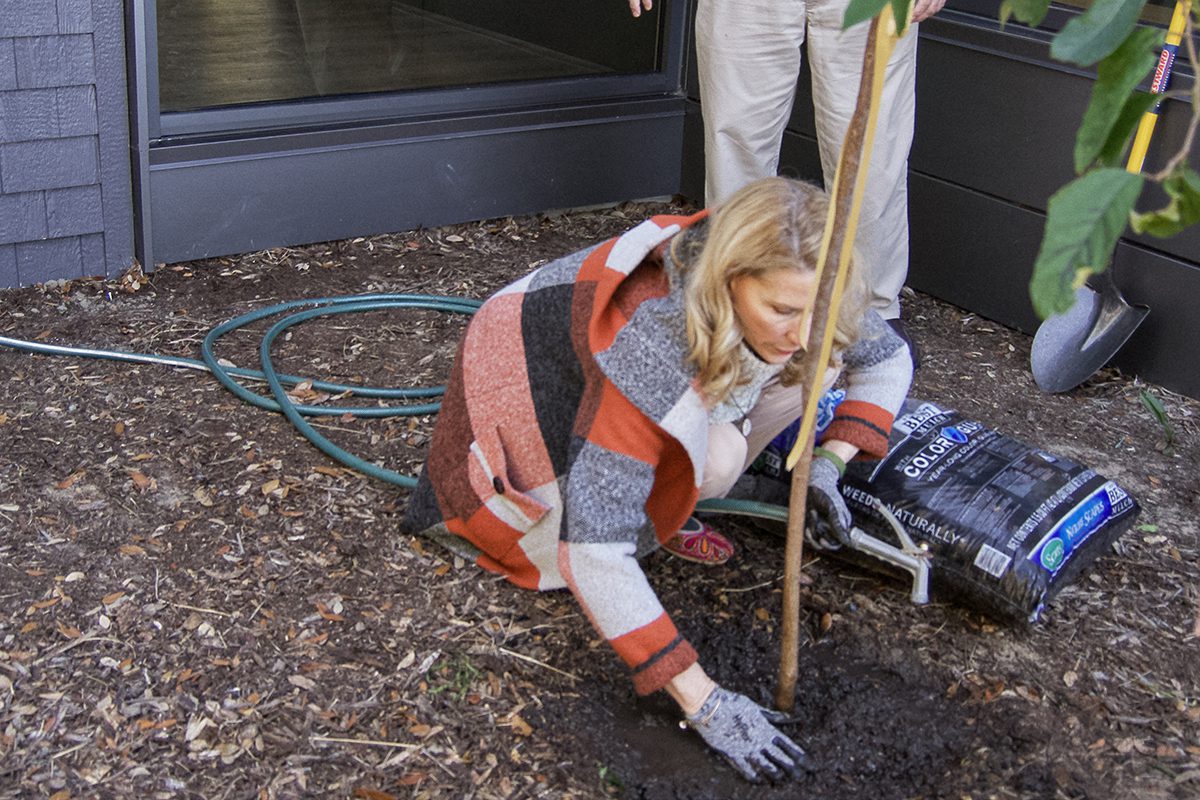
NAGS HEAD — Standing Wednesday at the end of a short path lined with beautyberries and seaside goldenrod at Jockey’s Ridge State Park, North Carolina First Lady Kristin Cooper told a gathering of about two dozen that, although she was here to celebrate North Carolina Native Plant Week, Oct. 16 to 22, it wasn’t plants that first drew her attention — it was her fascination with birds.
And because native plant species are so vital for North Carolina’s birds and pollinators, Cooper has been a vocal advocate for planting native species of trees, flowers and vegetation almost from the time her husband Gov. Roy Cooper took office in 2017.
Supporter Spotlight
Birds, she explained, began to thrive and increase in numbers at the North Carolina Executive Mansion soon after a project that stripped away dozens of nonnative ornamentals that had choked out other species in the garden there and replaced them with native plants.
“We put it (a native plant garden) in October, and the next spring, we had the kids come out and do a bird count,” she said. “Then a couple of years later they came back … and we saw a 25% uptick in the variety of birds that we saw — just in those two years.”
In July, the North Carolina Department of Natural and Cultural Resources instituted a policy that required all landscaping and planting at state parks, including Jockey’s Ridge, historic sites and other facilities the department manages to use only native plants in their landscaping.
“This is government trying to lead by example, by doing this, we’re trying to encourage businesses, homeowners, homeowners associations, other government agencies to embrace native plants as well,” said Department of Natural and Cultural Resources Secretary Reid Wilson, who, along with Audubon North Carolina Executive Director Curtis Smalling, were at the event.
The project at the mansion had sprung from a conversation Cooper had with folks with Audubon North Carolina when her husband was still the state attorney general.
Supporter Spotlight
“I’ve got to give a lot of the glory to the Audubon Society,” she said. “Some very astute person must have been at some place hearing me talk about how much I like birds.”
Cooper wasn’t here just to talk about plants. She also joined in planting a persimmon tree by the visitor center at the state park. Persimmon trees are abundant among the dunes and maritime trees of Jockey’s Ridge. The trees are a magnet for wildlife with innumerable birds and mammals gathering at the trees when the fruit ripens.
After the event, Cooper told Coastal Review why she is so passionate about native plants.
“Birds, even hummingbirds, mostly what they eat are bugs,” she said.

And while birds do eat seeds, insects make up the bulk of their diet, she noted. “A native oak tree might have 250 insects they can eat. A crepe myrtle maybe has two.”
It’s not just birds that thrive among native plants.
“I had a problem with a rabbit just eating my native plant, and that’s the point — they won’t eat that (other) stuff. They just hop right through it (nonnative plants) and come over and eat the plants you want there,” she said.
Wilson, during his remarks, also extolled the virtues of native plants.
“They are part of our natural and cultural heritage,” he said. “They are better able to survive and thrive because they’re adapted to our weather and to our soils.”
Smalling, with Audubon North Carolina, said the organization had begun the initiative 10 years ago as a collaborative effort among a group of volunteers including state park staff, the North Carolina Wildlife Resources Commission, aid groups and others. It was Cooper’s advocacy, however, that really moved the idea forward.
“One of the significant things that happened early in the process was First Lady Cooper stepped up and really became an important partner for us. Elevating the role of native plants and what they do for birds was really critical to understanding the connection,” Smalling said.
But a big issue that could hurt the campaign to get more native plants in the ground is nurseries’ inventories.
“Now that we want everybody to be planting native plants, we’ve got to make sure they’re available,” he said.
Smalling told Coastal Review that 2014 had been the first year that Audubon North Carolina began the native plants push. He said that initial effort illustrated what can happen when an idea gets too far ahead of inventory.
“The first year we did this, we said everybody needs to plant a spicebush because it’s great for migratory birds,” Smalling said. “Immediately, everybody was sold out of spicebush. We created the statewide shortage.”
Audubon North Carolina has subsequently developed a short list of six or seven plants it recommends each year so that nurseries can plan accordingly. Nonetheless, there are still supply chain issues, but now, Smalling noted, to the state’s native plant initiative is critical to making native plants more available.
“That’s why the policy that Secretary Wilson was talking about is really important. If you can drive that demand, as long as the growers see that there’s built-in demand, they can start ramping up,” he said.







